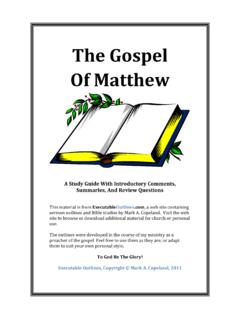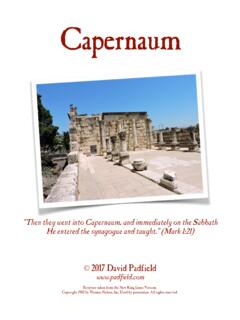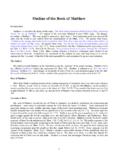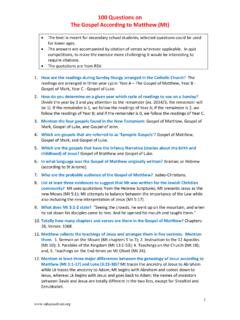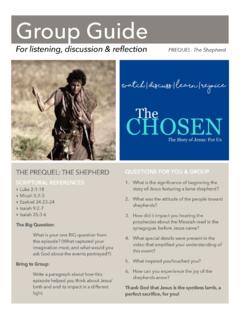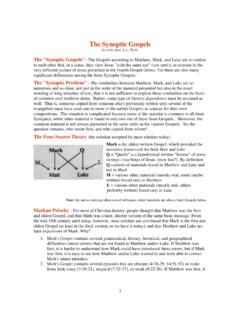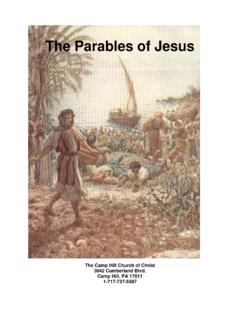Transcription of Study of the New Testament - Master Study Guide
1 The Bible Challenge The Study of the New Testament A Weekly Guide to the Study of the Bible The Rev. Charles L. Holt St. Peter's Episcopal Church, Lake Mary FL. 2013. Study of the New Testament Preliminaries for Understanding the New Testament The Nature and Origin of the New Testament (A) The Nature of the New Testament a. Testament term that refers to God's special dealings with Humanity i. The term is synonymous with the term Covenant . ii. Noah, Abraham, David iii. Most significant is the Covenant with Moses (forms the framework of what we commonly now call the Old Testament . iv. New Covenant (or Testament ) was prophesied in Jeremiah 31:31 33. b. New Covenant i. The believers in Jesus used the language of Jeremiah (2 Cor.))
2 3:6; Gal. 4:24 26). ii. All of the accounts of the Last Supper use the term covenant/ Testament . (Mk. 14:24; Matt. 26:28; Lk. 22:20; 1 Cor. 11:25). iii. Through the Incarnation, Death and Resurrection of Jesus, YHWH was instituting his New Covenant as promised. This New Covenant was not like the covenant made with their ancestors (Jeremiah 31:32). c. Only in the 2nd Century do we have evidence of Christians using the term New Testament ' for a body of writings, ultimately leading to the use of the designation of Old Testament ' for the Scriptures of Israel. 1. (B) How the First Christian Books were Written, Preserved and Collected a. The Coming into being of Books Written by Christians.
3 I. Jesus never wrote any of his teachings down. ii. The Early Christians were strongly focused on the last times . Ex. Acts 1:6. Lord, will you at this time restore the Kingdom to Israel? . iii. Letters. The first Christian writings were the first Christian literature. Paul was a traveling apostle who went from town to town planting new congregations. Letters were his primary way of communicating to the various congregations and their leaders. iv. Gospels. Somewhere in the 60's to early 70 AD it became clear that it was imperative that the memory of Jesus' words and deeds did not perish with the first eyewitnesses. As Peter writes in his second letter: 1:13 I think it right, as long as I am in this body, to stir you up by way of reminder, 14 since I know that the putting off of my body will be soon, as our Lord Jesus Christ made clear to me.
4 15 And I will make every effort so that after my departure you may be able at any time to recall these things. 1. Brown, Raymond, An Introduction to the New Testament , (Doubleday: New York, 1997) p. 4. 2. v. Acts; Revelation and Other Literary Genres. 1. The Book of Acts arose as a sequel to the Gospel of Luke. Luke felt it was important to create an orderly account which told the story of Jesus and the founding of Christianity. 2. Revelation (also called the Apocalypse) is written in a genre similar to the Old Testament Prophetic Books. 3. Other writings: are more in the genre of written sermons or theological discourses. Examples include the Book of James or Hebrews. b. The Preservation and Acceptance of Books Written by Christians i.
5 These early letters and writings were copied and shared beyond their original recipients with other congregations and individual church leaders. ii. Over time they formed authoritative collections. The basis for inclusion in what would become the Canon of the New Testament was the following: 1. The basis for inclusion in an authoritative collection was that either the work was written by an apostle or by apostolic men closely associated with Apostles (ex. Mark and Silvanus were companions of Peter and Luke was a companion of Paul). 2. The communities to whom they were written played a key role in winning acceptance and confirming authenticity. 3. Conformity with the Rule of Faith a.
6 The term canon or norm may have first applied to the standard of beliefs and practices of the Christian communities before it referred to the collection of writings that became standard. b. The Letter of Jude speaks of a faith once for all delivered . 3. Beloved, although I was very eager to write to you about our common salvation, I found it necessary to write appealing to you to contend for the faith that was once for all delivered to the saints. c. There were other writings and teachings offering and the early church often used the rule to disregard these other writings. For example, Eusebius writes about a Bishop Serapion who wrote concerning the So called Gospel of Peter : We, dear brother, receive both Peter and the other apostles as Christ, but writings falsely attributed to them we reject, knowing that such were not handed down to us.
7 When I visited you, I presumed that all of you adhered to the true faith, so instead of going through the gospel alleged by them to be Peter's, I. said: If this is the only thing that seems to engender quibbling notions among you, then read it. But since I now learn that they are ensnared in some heresy, I will strive to visit you soon, brothers Others have studied this gospel, namely the successors of those who produced it, whom we call Docetists, for the ideas reflect their teaching. (From the Greek dokein, to seem, the term was applied to those who claimed the Son of God seemed to have a physical nature but not in reality. 3. (C) The New Testament as Inspired Scripture a.)
8 Peter calls the writings of Paul: Scripture in 2 Peter 3: 15. And count the patience of our Lord as salvation, just as our beloved brother Paul also wrote to you according to the wisdom given him, 16 as he does in all his letters when he speaks in them of these matters. There are some things in them that are hard to understand, which the ignorant and unstable twist to their own destruction, as they do the other Scriptures. b. For Peter, Scripture was inspired by God in 2 Peter 1: 20. knowing this first of all, that no prophecy of Scripture comes from someone's own interpretation. 21 For no prophecy was ever produced by the will of man, but men spoke from God as they were carried along by the Holy Spirit.
9 C. In Paul's 2nd letter to Timothy we read in chapter 3: 16. All Scripture is breathed out by God and profitable for teaching, for reproof, for correction, and for training in righteousness, 17 that the man of God may be complete, equipped for every good work. The Gospels Synoptic Gospels (A) The word Gospel means Good News . It comes from the Greek word evangelion. An evangelist is someone who tells the Good News about Jesus Christ. (B) The first three Gospels are often grouped together as the Synoptic Gospels because they are similar . The structure of the Gospel of John stands apart from the other three and is the most theological of the 4 Gospels. (C) Three Stages of Gospel formation: a.
10 The Public Ministry of Jesus of Nazereth (30 33 AD). i. Jesus went around proclaiming the Good News . See Mark 1:14 15. b. The Apostolic Preaching about Jesus (33 AD 70 AD). i. The word Apostles means sent forth ones . ii. The Apostles were commissioned by Jesus and sent forth to preach the Good News to the ends of the earth . See Acts 1:8. c. The Written Gospels (60 AD 100 AD). i. Two Gospels are attributed to Apostles: matthew and John. ii. Two Gospels are attributed to Apostolic Men : Mark [of Peter] and Luke [of Paul]. iii. The Synoptic Gospels were interdependent in their formation in that they contain many similar teachings and accounts of Jesus in common. iv. John appears to have been written last and independent of the writing of the other three gospels.
